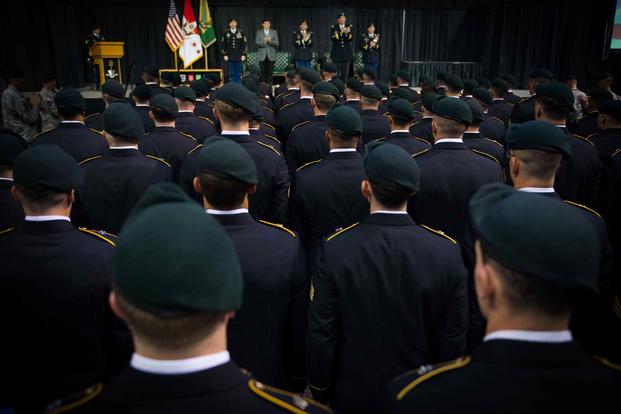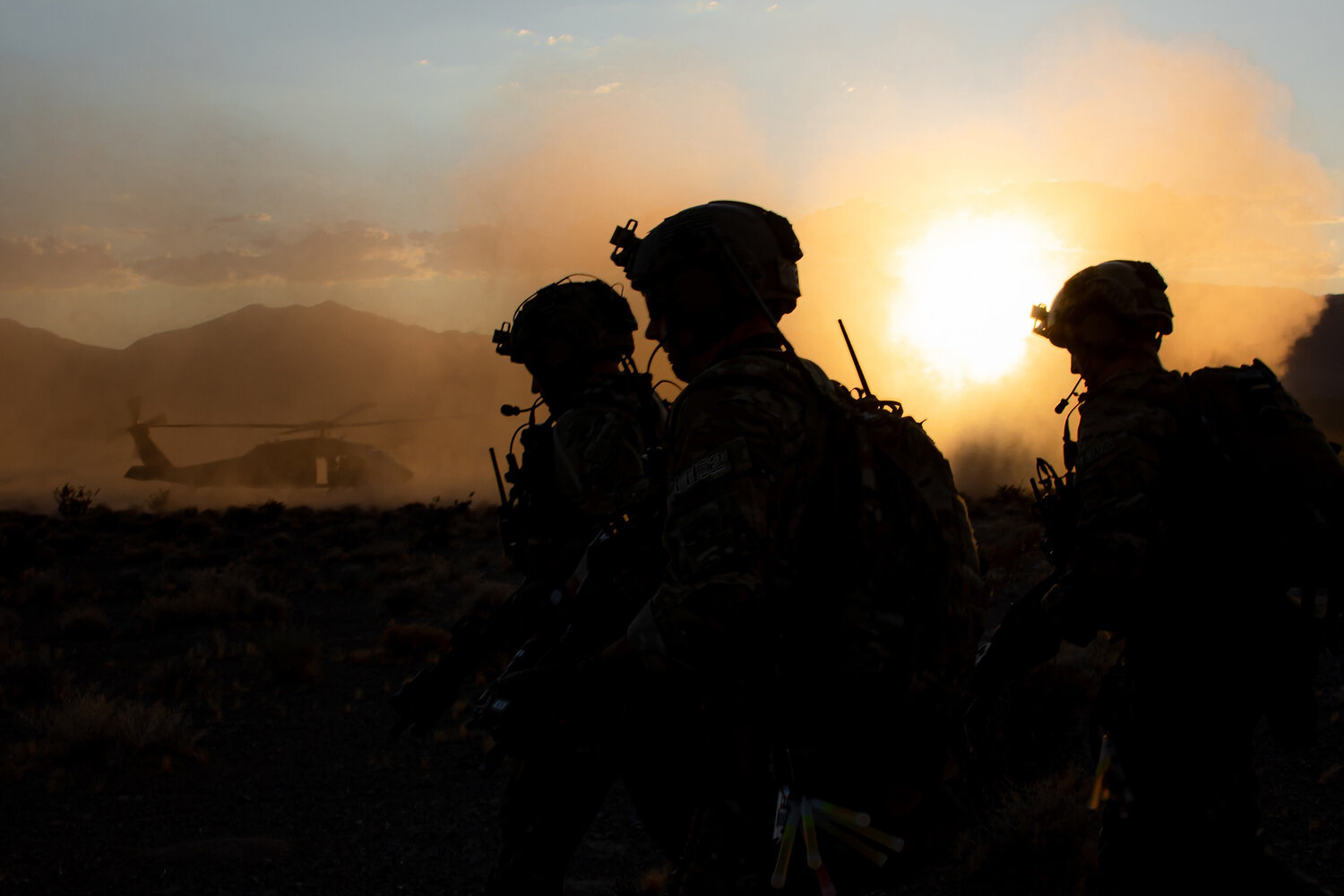https://www.armyrecognition.com/sep...ombat-focused_marksmanship_qualification.htmlSoldiers across the 25th Infantry Division with varying skill levels prepared for the new marksmanship standards by conducting a pilot program to assess current installation support capabilities at Schofield Barracks, Hawaii. The new four-phase course will now feature standing firing positions. Soldiers are issued four 10-round magazines to engage 40 pop-up targets from the four shooting positions. Soldiers start in the standing position then go to the prone unsupported, then prone supported, kneeling supported and finally the standing supported position. Soldiers utilize a barricade and will have 8-10 second intervals to change magazine and positions.
The new course will replace the current marksmanship qualification course with one that requires Soldiers to engage targets faster and to operate as they would during an enemy engagement. "The old qualification did not help in combat situations, so they incorporated magazine exchanges and position changes by yourself to represent combat," said Staff Sgt. Tadeysz Showers, assigned to the 25th Sustainment Brigade. "No matter the military occupational specialty (MOS), any MOS can teach a Soldier how to do this new weapons qualification."
The division marksmanship pilot program was led by the Lightning Academy Senior Instructor Staff Sgt. Daniel Martin and three other instructors through preliminary marksmanship instruction (PMI), Engagement Skills Trainer (EST), and qualification tables on a standard pop-up range.
In the current qualification course, soldiers take instructions from the range tower, such as when to change magazines and firing positions. "Now, the qualification only has commands to begin the qualification and when it has ended," said Martin. "The four 10-round magazines will be in your kit, and you will transition your position and conduct magazine changes on your own without any commands from the tower."
"The new qualification saves time," said Showers. "The old qualification took about 20 minutes, this one takes about four minutes to execute and is much faster paced." The course is set to become the Army-wide standard for rifle marksmanship. Qualification implementation begins October 2019.
"The new qualification is more challenging, but a lot more realistic," said Martin. "Some soldiers have never conducted magazine exchanges on their own without being told when to on the line during the Automatic Record Fire. The course is helping the Army become more efficient in urban combat scenarios."
"Soldiers start by receiving a series of classes on how to properly zero the rifle, whether it's a bare rifle or with optics," said Showers. "Soldiers received classes on laser bore sight, Minute of Angle (MOA), zeroing process, windage, ballistics, and also received EST training and practiced position changes before going to a live range."
The new weapons qualification maintains the same score requirements as the current system to pass in each category; soldiers must hit 23 targets out of 40 to qualify. Soldiers must hit 23 to 29 targets for a Marksman rating, 30 to 35 for Sharpshooter and 36 to 40 to qualify for Expert. "This new weapons qualification is more combat oriented with changing positions, changing magazines and engaging the targets," said Sgt. Octavius Moon assigned to the 25th Sustainment Brigade. "This will help Soldiers shoot better as well as make ranges faster and have more Soldiers qualified. It helps Soldiers become more knowledgeable about their weapon as well."
Install the app
How to install the app on iOS
Follow along with the video below to see how to install our site as a web app on your home screen.
Note: This feature may not be available in some browsers.
You are using an out of date browser. It may not display this or other websites correctly.
You should upgrade or use an alternative browser.
You should upgrade or use an alternative browser.
Amerikkalainen sotataito
- Viestiketjun aloittaja late347
- Aloitus PVM
viestiupseeri
Alikersantti

U.S. Military Could Collapse Within 20 Years Due to Climate Change, Report Commissioned By Pentagon Says
The report says a combination of global starvation, war, disease, drought, and a fragile power grid could have cascading, devastating effects.
Mielenkiintoista luettavaa, mutta erityisesti seuraava kiinnitti huomion:
"Water is currently 30-40 percent of the costs required to sustain a US military force operating abroad, according to the new Army report. A huge infrastructure is needed to transport bottled water for Army units. So the report recommends major new investments in technology to collect water from the atmosphere locally, without which US military operations abroad could become impossible. The biggest obstacle is that this is currently way outside the Pentagon’s current funding priorities."
Kuulostaa 30-40% kovalta luvulta, mutta jos hiekkamaissa puuhaillaan niin kyllähän siinä hintaa tulee vaikka omia pullottamoita rakennetaan: https://www.army.mil/article/22354/water_bottling_plant_opens_begins_production_in_southern_iraq
US Forces Untrained, Unready For Russian, Chinese Jamming - Breaking Defense
Training for electronic warfare threats is too easy, leaving troops dangerously unready for great power conflict. Scenarios are so unrealistic that one officer called them "garbage."
"US troops have forgotten basic lessons of electronic warfare, and they’re not being forced to relearn them because even major training exercises are unrealistically easy, military and civilian experts warned this morning. Even when electronic warfare specialists are allowed to disrupt a unit’s radios and radar, often to paralyzing effect, they’re typically told to knock it off so training can continue as normal."
Pihatonttu
Respected Leader
US Forces Untrained, Unready For Russian, Chinese Jamming - Breaking Defense
Training for electronic warfare threats is too easy, leaving troops dangerously unready for great power conflict. Scenarios are so unrealistic that one officer called them "garbage."breakingdefense.com
"US troops have forgotten basic lessons of electronic warfare, and they’re not being forced to relearn them because even major training exercises are unrealistically easy, military and civilian experts warned this morning. Even when electronic warfare specialists are allowed to disrupt a unit’s radios and radar, often to paralyzing effect, they’re typically told to knock it off so training can continue as normal."
Kannattaa kattoa tuubista, mitä Karber puhuu USA:n ja Venäjän ELSO-kapasiteeteista.
Voisi tiivistää niin, että USA on teknisesti pidemmällä, mutta laitteita, koulutusta, harjoittelua, kokemusta tms. ei ole sodankäynnin ruohonjuuritasolla. Venäjä ei ole teknologisesti yhtä pitkällä, mutta laitteita, koulutusta, harjoittelua, kokemusta yms. on valtavat määrät ruohonjuuritasolla ja sitä käytetään todella massoittain.
Tuubiin hakusanoiksi Phillip Karber ja tulee eteen paljon mielenkiintoista tavaraa.
PJ85
Eversti
Jenkkien organisaatiot kiinnostaa. ABCT, SBCT ja IBCT on aika hyvin hallussa, mutta osaisiko joku sanoa näissä ilma elementin omaavista jalkaväkiprikaateista.
-Ensinnäkin mitä eroa on maahanlasku ja ilmarynnäkköprikaateilla?
-Ilmeisesti prikaateilla ei ole orgaanista lentokalustosa ml heko ?
-Onko prikaateilla paljon ajoneuvokalustoa ja jos on, millaista?
Kiitän vastauksista!
-Ensinnäkin mitä eroa on maahanlasku ja ilmarynnäkköprikaateilla?
-Ilmeisesti prikaateilla ei ole orgaanista lentokalustosa ml heko ?
-Onko prikaateilla paljon ajoneuvokalustoa ja jos on, millaista?
Kiitän vastauksista!
kimmo.j
Greatest Leader
Käsittääkseni karkea jako on se, että maahanlaskuprikaati kykenee hyppäämään laskuvarjolla kohteeseen ja ilmarynnäkköprikaati lentää helikoptereilla sinne.Jenkkien organisaatiot kiinnostaa. ABCT, SBCT ja IBCT on aika hyvin hallussa, mutta osaisiko joku sanoa näissä ilma elementin omaavista jalkaväkiprikaateista.
-Ensinnäkin mitä eroa on maahanlasku ja ilmarynnäkköprikaateilla?
-Ilmeisesti prikaateilla ei ole orgaanista lentokalustosa ml heko ?
-Onko prikaateilla paljon ajoneuvokalustoa ja jos on, millaista?
Kiitän vastauksista!
Ei taida olla ilmakalustoa prikaatissa. Lisäksi Infantry on myös air assault kykyinen. Ajoneuvot on Humvee ja seuraaja, Stryker-prikaatilla Strykerit, armoured teloilla.
Perussettiä Wikistä https://en.m.wikipedia.org/wiki/Brigade_combat_team
Perussettiä Wikistä https://en.m.wikipedia.org/wiki/Brigade_combat_team
Osasto 31
Kapteeni
USA:n armeijan maanalaisten operaatioiden julkaisu/manuaali: https://www.theblackvault.com/docum...hniques-publication-no-3-21-51-november-2019/
ATP 3-21.51 provides doctrinal guidance and direction for all brigade combat teams (BCTs) and their subordinate elements conducting subterranean operations. The principal audience for ATP 3-21.51 is all members of the profession of arms. Commanders and staffs of Army headquarters serving as joint task force (JTF) or multinational headquarters should also refer to applicable joint or multinational doctrine concerning the range of military operations and joint or multinational forces. Trainers and educators throughout the Army will also use this publication.
Osasto 31
Kapteeni
Linkki: https://www.armytimes.com/news/your...s-could-be-here-by-2050-dod-study-group-says/
Cyborg warriors could be here by 2050, DoD study group says
Ear, eye, brain and muscular enhancement is “technically feasible by 2050 or earlier,” according to a study released this month by the U.S. Army’s Combat Capabilities Development Command.
The demand for cyborg-style capabilities will be driven in part by the civilian healthcare market, which will acclimate people to an industry fraught with ethical, legal and social challenges, according to Defense Department researchers.
Implementing the technology across the military, however, will likely run up against the dystopian narratives found in science fiction, among other issues, the researchers added.
The report — entitled “Cyborg Soldier 2050: Human/Machine Fusion and the Implications for the Future of the DOD” — is the result of a year-long assessment.
It was written by a study group from the DoD Biotechnologies for Health and Human Performance Council, which is tasked to look at the ripple effects of military biotechnology.
Kustaanmiekka
Kenraali
Tässä uusin Radio Kipinän Podcast kuunneltavaksi.
Podcastissä puhutaan yhdysvaltalaisten uudesta sotataidollisesta ajattelusta, mosaiikkisodankäynnistä.
Yhdysvaltojen armeija on tullut siihen tulokseen, että he eivät näe enään itseään ylivoimaisena taistelukentällä ja taistelukenttä ei ole systemaattisesti heidän hallittavissa. Totaalinen hallinnan tunne puuttuu.
Tämä on pakottanut uuteen ajattelutapaan.
Radio Kipinän kolmannen kauden neljännessä jaksossa everstiluutnantti ja valtiotieteen tohtori, Juha Mälkki Puolustusvoimien tutkimuslaitokselta puhuu yhdysvaltalaisten uudesta sotataidollisesta ajattelusta. Jaksossa käsitellään Yhdysvaltojen sotataidollisen ajattelun muutosta ja sitä, kuinka heidän ajattelunsa sodankäynnistä on muuttumassa voimasuhteiden eron kavennettua.
Podcastissä puhutaan yhdysvaltalaisten uudesta sotataidollisesta ajattelusta, mosaiikkisodankäynnistä.
Yhdysvaltojen armeija on tullut siihen tulokseen, että he eivät näe enään itseään ylivoimaisena taistelukentällä ja taistelukenttä ei ole systemaattisesti heidän hallittavissa. Totaalinen hallinnan tunne puuttuu.
Tämä on pakottanut uuteen ajattelutapaan.
Radio Kipinän kolmannen kauden neljännessä jaksossa everstiluutnantti ja valtiotieteen tohtori, Juha Mälkki Puolustusvoimien tutkimuslaitokselta puhuu yhdysvaltalaisten uudesta sotataidollisesta ajattelusta. Jaksossa käsitellään Yhdysvaltojen sotataidollisen ajattelun muutosta ja sitä, kuinka heidän ajattelunsa sodankäynnistä on muuttumassa voimasuhteiden eron kavennettua.
Pihatonttu
Respected Leader
Podcastissä puhutaan yhdysvaltalaisten uudesta sotataidollisesta ajattelusta, mosaiikkisodankäynnistä.
Radio Kipinän kolmannen kauden neljännessä jaksossa everstiluutnantti ja valtiotieteen tohtori, Juha Mälkki Puolustusvoimien tutkimuslaitokselta..
Kiinnostava pätkä. Yhteys Suomen tilanteeseen vahva.
Olen ajan mittaan tottunut pitämään tota Mälkkiä fiksuna ja osaavana tyyppinä. Muut arvioikoot onko kuva oikea vai väärä. Aika suppean aineiston perusteella tämä mielikuva on kuitenkin syntynyt.
tosilukuja.
U.S. Military Could Collapse Within 20 Years Due to Climate Change, Report Commissioned By Pentagon Says
The report says a combination of global starvation, war, disease, drought, and a fragile power grid could have cascading, devastating effects.www.vice.com
Mielenkiintoista luettavaa, mutta erityisesti seuraava kiinnitti huomion:
"Water is currently 30-40 percent of the costs required to sustain a US military force operating abroad, according to the new Army report. A huge infrastructure is needed to transport bottled water for Army units. So the report recommends major new investments in technology to collect water from the atmosphere locally, without which US military operations abroad could become impossible. The biggest obstacle is that this is currently way outside the Pentagon’s current funding priorities."
Kuulostaa 30-40% kovalta luvulta, mutta jos hiekkamaissa puuhaillaan niin kyllähän siinä hintaa tulee vaikka omia pullottamoita rakennetaan: https://www.army.mil/article/22354/water_bottling_plant_opens_begins_production_in_southern_iraq
Me portaan aina kalvot ja tutkitaan, että Voiko vettä käyttää ja miten sen pystyy suodattamaan sekä pullottamaan.
Ensimmäinen nainen vihreisiin baretteihin.

 www.military.com
www.military.com

The Army Is About to Get its First Female Green Beret
A female soldier is scheduled to graduate from the Special Forces Qualification Course in July and become the first woman to join the Green Berets.
Hyvä artikkeli, jossa tohditaan ehdottaa ettei multi-domain höntyily ole ehkä kestävä ajatus kulutussodassa, jollaiseksi kahnaus peer adversaryn kanssa helposti taantuisi.

 thestrategybridge.org
thestrategybridge.org

Rushing to Defeat: The Strategic Flaw in Contemporary U.S. Army Thinking
Commonly referred to as multi-domain operations, the concept embraces short war thinking and promotes a vision of war conditioned entirely on speed. According to the concept, U.S. Army formations operating as part of the joint force create or leverage effects at decisive spaces across multiple domai
Through multiple wargames and exercises following the events in Crimea, the Army has concluded that Russia, for example, can achieve its military and political objectives in the Baltic in under three days, a fait accompli too costly to contest.[3] Such rapid aggression requires an equally rapid response.
Viimeksi muokattu:
tulikomento
Supreme Leader
Ensimmäinen nainen vihreisiin baretteihin.

The Army Is About to Get its First Female Green Beret
A female soldier is scheduled to graduate from the Special Forces Qualification Course in July and become the first woman to join the Green Berets.www.military.com
Oikeastaan ei ollut ihan ensimmäinen. Vuonna 1980 muuan naiskapteeni suoritti kurssin mutta hänen ei annettu valmistua.

New female Green Beret is a huge milestone, but she isn’t the first to earn the title
“The moment I got accepted, it was like I crossed a major line and the ‘you-know-what’ hit the fan," said Wilder.
Falangi
Kenraali
Vaikka tähän ketjuun... Tyyppi joka palveli ensin kahdeksan vuotta Navy Sealina, minkä jälkeen vasta päätti toteuttaa lapsuuden unelmansa ja pyrkiä lentäjäksi sotilasilmailuun. Lensi sitten 13 vuotta Chinookia erikoisjoukkojen helikopterirykmentissä.

 en.wikipedia.org
en.wikipedia.org

